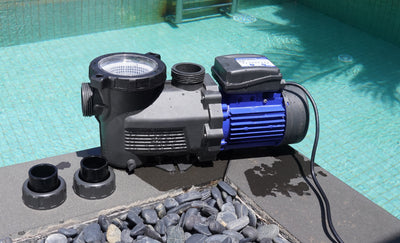How Does a Pool Pump Work to Keep Your Pool Perfect?
Your pool pump is one of the essential components in your pool system. Without it, water would stagnate, leaving your pool cloudy, unfiltered, and prone to algae growth. Here’s how a pool pump works and some troubleshooting tips to keep it running smoothly.
How a Pool Pump Works
Your pool pump acts as the heart of your pool, circulating water through the plumbing and filter system. As it pumps water, the system ensures that any added chemicals are evenly dispersed, maintaining balanced water conditions. Here’s a simple breakdown of how it all flows:
- Suction Side: The pump pulls water from the pool via the skimmers and main drain, drawing it into the suction lines.
- Filtration and Heating: Once the water enters the pump, it’s forced into the filter, where impurities are removed. Some setups also send water through a heater, chlorinator, or salt system before returning it to the pool.
- Pressure Side: The filtered water is pushed through the return lines and back into the pool through the return jets, completing the cycle.
Anatomy of a Pool Pump
Understanding the parts of a pool pump can make troubleshooting much easier:
- Pump Lid: A sealed lid is crucial to prevent air from entering, which can disrupt suction.
- Pump Strainer Basket: This basket catches debris, preventing clogs that can hinder the impeller.
- Drain Plug: This is used to remove water during winterizing.
- Pump Housing and Impeller: Inside the housing, the impeller spins, creating a vacuum that pulls water from the pool and pushes it toward the filter. Clogs here can stop the pump entirely.
- Motor and Shaft: The motor powers the impeller, driving the circulation process.
Choosing the Right Pump Size for Your Pool
A pump must be powerful enough to turn over all the water in your pool at least once daily. This process is known as the turnover rate. To calculate it:
- Start with your pool’s volume in gallons.
- Divide by the pump’s flow rate (usually in gallons per minute).
For instance, if you have a 15,000-gallon pool and a pump with a 40 GPM flow rate, your turnover rate would be about 375 minutes (just over 6 hours) for a full cycle. Running your pump for an adequate time helps prevent water issues and reduces strain on the system.
Pool Pump Maintenance Tips
Routine checks can help keep your pump working effectively:
- Clean the Pump Basket Regularly: Empty the pump basket of any debris that could clog the impeller. Be sure to turn off the pump first.
- Check the Pump Lid Seal: Inspect the O-ring for wear, as any damage can allow air into the system, reducing suction. Use a proper O-ring lubricant or replace it if needed.
- Inspect Pump Connections: Loose connections can introduce air leaks. Tighten connections and consider plumber’s tape for added seal protection.
- Maintain Water Level: Keep water at least halfway up the skimmer to prevent air from entering the pump.
- Clean Skimmer Basket and Filter: Clear the skimmer basket weekly and clean or backwash the filter as needed to support optimal water flow.
- Check for Obstructions in the Skimmer Line: Sometimes items like hair ties or goggles can block the line. If you suspect a blockage, consult a guide to unclog your skimmer line safely.
Troubleshooting Common Pool Pump Issues
If you’re experiencing reduced water flow or other issues, try these steps:
- Priming the Pump: If there’s low water flow, fill the pump with a garden hose for a couple of minutes to remove trapped air, then reseal the lid.
- Detecting Air Leaks: Spread shaving cream around suspected leak points. If there’s an air leak, it will create an indentation where air is being sucked in.
- Addressing Motor Noise: A humming noise often signals motor trouble. Resetting the breaker or checking for a jammed impeller may help resolve the issue.
Regular maintenance and understanding how each component functions can keep your AQUASTRONG pool pump working efficiently. With the right care, your pool pump will support a clean, clear pool season after season.

